The Fundamentals of Sword & Planet, Part V: Lin Carter

I consider Edgar Rice Burroughs and Otis Adelbert Kline to be the first generation of Sword & Planet authors. Probably most widely known among the second generation — whether rightly or wrongly — is Lin Carter. Carter was an enthusiastic fellow who loved all things fantasy, including S&P and Sword & Sorcery. He promoted the genres, edited many collections of fantasy stories, and was a tremendously prolific author himself.
I’ve read 41 books by him and still have about a dozen on my TBR shelves. And that’s NOT counting the Conan books he was associated with. He was everywhere when I was growing up and our small town library had more books by him than by ERB himself.
[Click the images for planet-sized versions.]
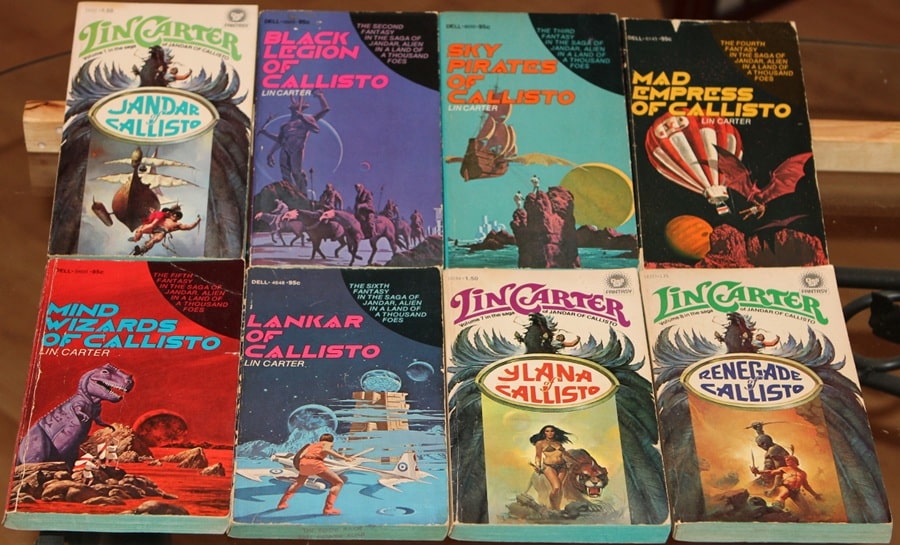
Carter made his life primarily by mining the literary waters discovered by ERB (S&P) and Robert E. Howard (S&S). His Thongor books are primarily Howardish, with a dash of John Carter. His Green Star and Callisto series are unabashed ERBian (John Carter). His Zanthodon series is a parallel with ERB’s Pellucidar books.
His Callisto series (above in their Dell paperback editions) are:
1. Jandar of Callisto (December 1972) — cover by Vincent Di Fate
2. Black Legion of Callisto (December 1972) — cover by Vincent Di Fate
3. Sky Pirates of Callisto (January 1973) — cover by Vincent Di Fate
4. Mad Empress of Callisto (February 1975) — cover by Vincent Di Fate
5. Mind Wizards of Callisto (March 1975) — cover by Vincent Di Fate
6. Lankar of Callisto (June 1975) — cover by Vincent Di Fate
7. Ylana of Callisto (October 1977) — cover by Ken Kelly
8. Renegade of Callisto (August 1978) — cover by Ken Kelly
And the Thongor novels (from Berkley Medallion, Tandem, Ace, Paperback Library, and Warner Books) are below. They are:
1. Thongor and the Wizard of Lemuria (Berkley Medallion, December 1969) — cover by Jeff Jones
2. Thongor of Lemuria (Tandem, January 1970, cover by Gerald Wood), later retitled Thongor and the Dragon City (Berkley Medallion, March 1976, cover by Vincent Di Fate)
3. Thongor Against the Gods (Tandem, 1970) — cover by Gerald Wood
4. Thongor in the City of Magicians (Warner Books, October 1979) — cover by Kevin Eugene Johnson
5. Thongor at the End of Time (Warner Books, December 1979) — cover by Kevin Eugene Johnson
6. Thongor Fights the Pirates of Tarakus (Berkley Medallion, June 1976) — cover by Vincent Di Fate
And yet, on a personal note, I never found his work as engaging as ERBs or Klines, or Leigh Brackett. I don’t dislike his stories; I wouldn’t have read so many if I had, but he never resonated with me the way some other S&P authors do.
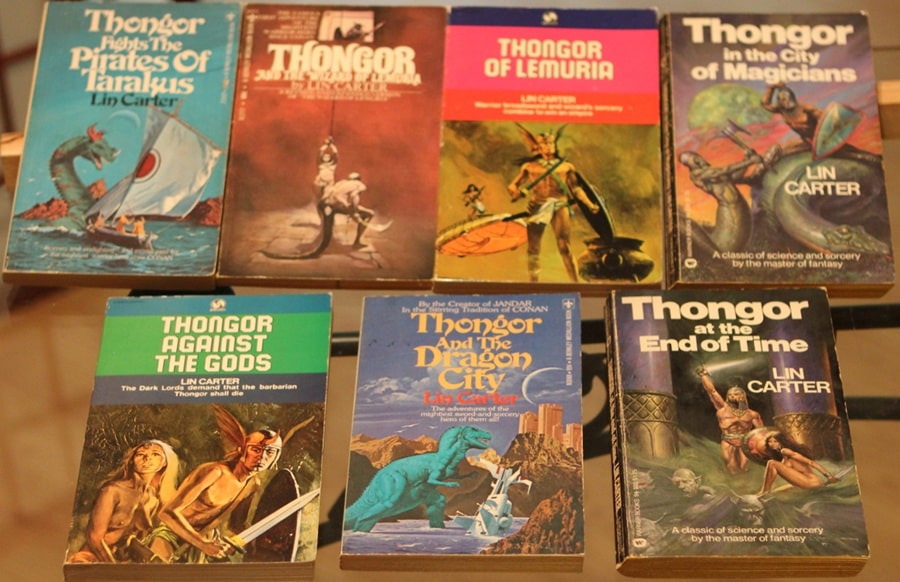
My favorite series by Carter is his Green Star books, very much S&P. I think they are his best work. The editions at top are all from DAW Books.
1. Under the Green Star (November 1972) — cover by Tim Kirk
2. When the Green Star Calls (July 1973) — cover by Luis Dominguez
3. By the Light of the Green Star (July 1974) — cover by Roy Krenkel
4. As the Green Star Rises (February 1975) — cover by Roy Krenkel
5. In the Green Star’s Glow (January 1976) — cover by Michael Whelan
Although Lin Carter’s Thongor series is set on an ancient Earth, on the lost continent of Lemuria to be precise, the stories are definitely Sword & Planet adjacent. The flying ships Thongor uses seem straight out of a Barsoom story, and there are numerous little touches here and there that remind one of ERB’s work.
The sheer amount of sorcery, though, and the setting, of course, place this series in the Sword & Sorcery camp.
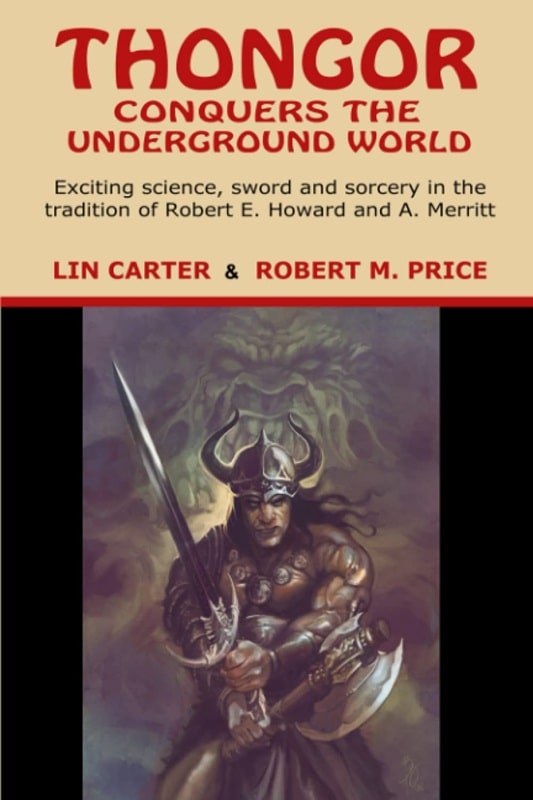 |
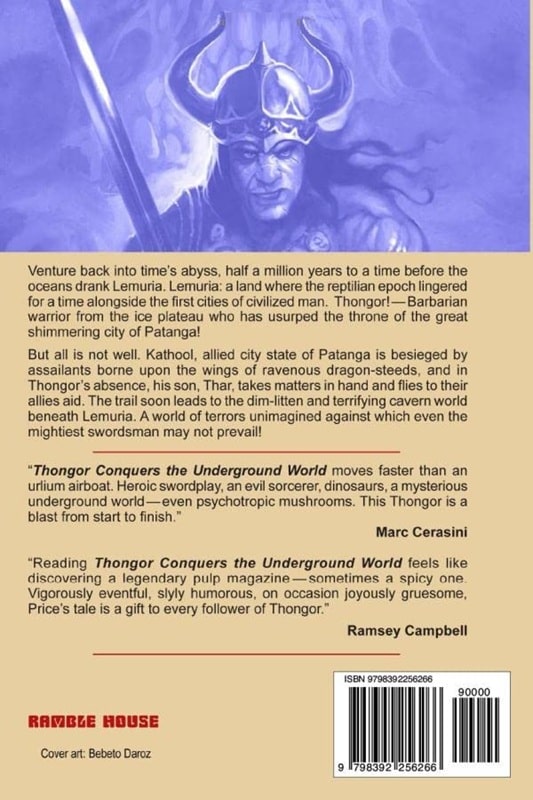 |
Thongor Conquers the Underground World by Lin Carter and Robert M. Price
(Ramble House, May 17, 2023). Cover by Bebeto Daroz
After Carter’s death his literary executor, Robert M. Price, continued Thongor’s adventures with some short stories and a novella called Thongor Conquers the Underground World, which was expanded from an outline Carter left behind. I also have an anthology of S&S tales that Price edited called The Mighty Warriors, which contains the short story “Thongor in the Valley of Demons.”
Price does a reasonable job with Thongor. I can hear Carter’s voice in the stories and there are still little S&P touches. The novella also had one totally bizarre scene in it that widened my eyes. I’ll have to try and ask Price if that was in the original Carter outline or if he added it on his own. It was definitely not ERBian.
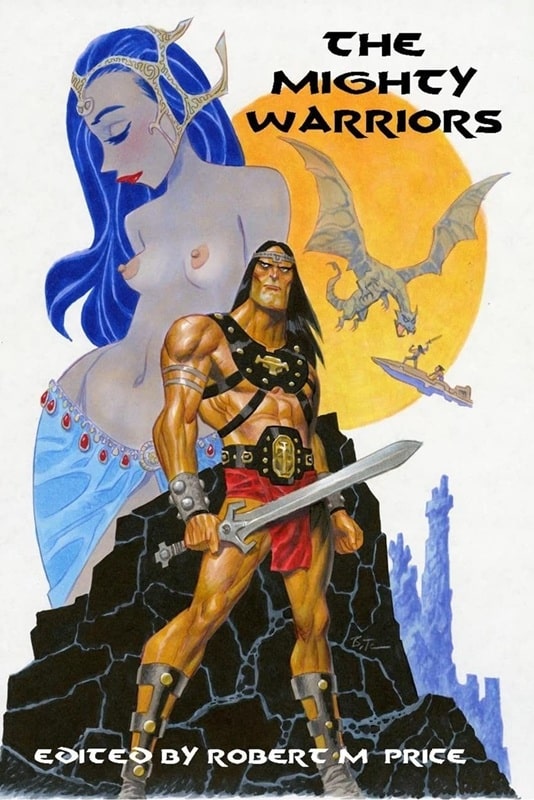 |
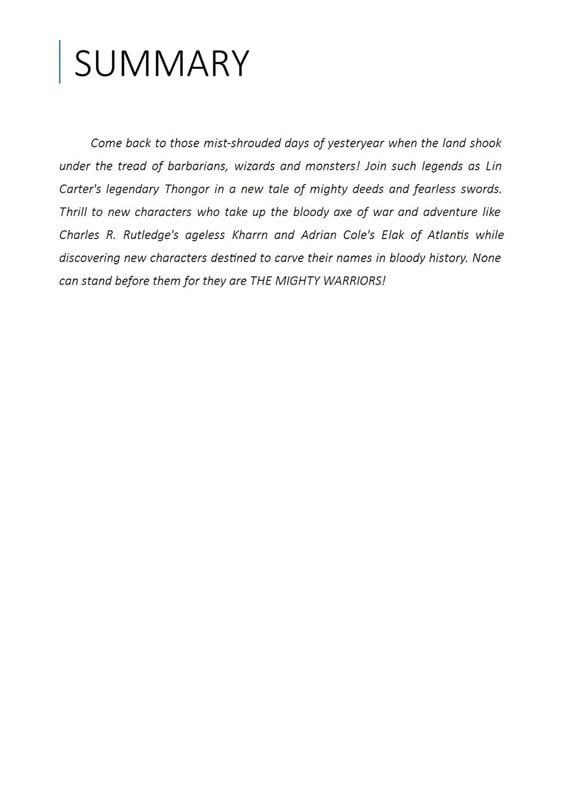 |
The Mighty Warriors, edited by Robert M. Price (Ulthar Press, May 13, 2018). Cover by Bruce Timm
Linwood Vrooman Carter wrote two more series that I’ll mention here. One, which might be considered Sword & Planet adjacent, is his World’s End series of six books (see below), the first published by Belmont and the rest by DAW.
1. The Warrior of World’s End (DAW, November 1974) — cover by Vincent Di Fate
2. The Enchantress of World’s End (DAW, May 1975) — cover by Michael Whelan
3 .The Immortal of World’s End (DAW, September 1976) — cover by Michael Whelan
4. The Barbarian of World’s End (DAW, May 1977) — cover by John Bierley
5. The Pirate of World’s End (DAW, October 1978) — cover by Richard Hescox
6. Giant of World’s End (Belmont Books, February 1969) — cover by Jeff Jones
The setting is Earth but in the vastly distant future where everything is altered. The moon’s orbit has decayed to the point where it looms gigantically over the earth and will soon crash into the planet to cause final destruction. All of Earth’s land masses have become combined into one super-continent called Gondwane. (I’m sure this name came from the real existence of Gondwana, a super continent that existed in Earth’s history about 510 million years ago.)

The hero is named Ganelon Silvermane, who turns out to be a genetic construct created far in the past. Silvermane is a giant of a hero who seems to combine elements of Conan, John Carter, and the cartoon character He-Man. There’s a lot of action and swashbuckling throughout the series, which I appreciated. Carter’s imagination is running on high throughout this series.
However, an element of the series that I didn’t personally find endearing is that it seems to have been written very “tongue-in-cheek.” There’s a lot more humor here than in any other of Carter’s series, and I found it more distraction than enjoyable. You might differ.
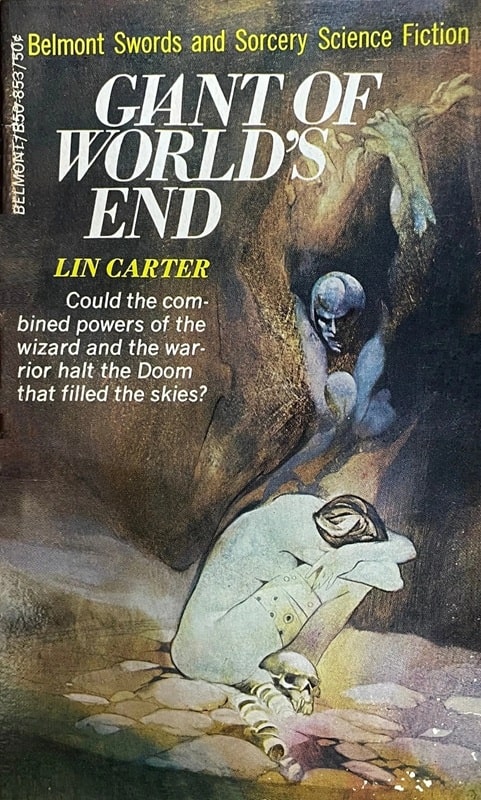 |
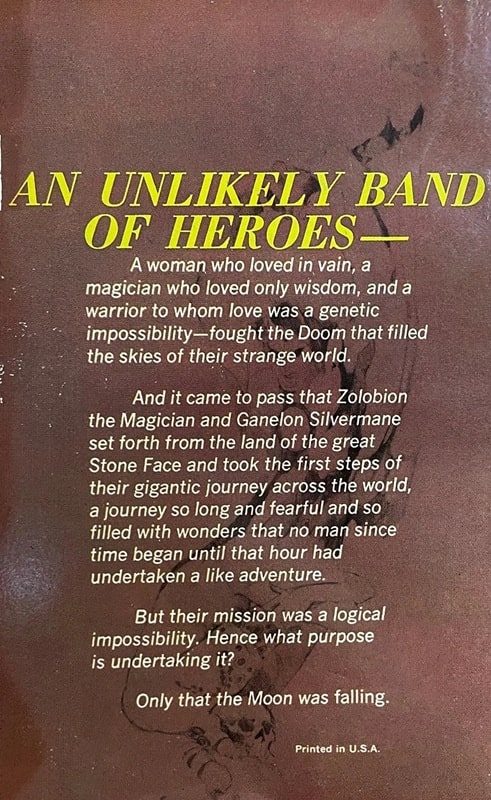 |
Giant of World’s End edited by Lin Carter (Belmont Books, February 1969). Cover by Jeff Jones
One important point to remember is that the first book written in the series is Giant of World’s End, but it’s actually the concluding book. Warrior of World’s End is the first book chronologically in the timeline of the story and is listed in my collection as “The First Book of the Gondwane Epic.” It’s clear that Carter wrote Giant, and then several years later decided to mine the same territory for more books. He produced the next five at a rate of one book a year.
The covers of the first five books (chronologically) were painted by:
Warrior – Vincent DiFate
Enchantress and Immortal – Michael Whelan
Barbarian – John Bierley
Pirate – Richard Hescox
Giant – Jeff Jones

The last of Lin Carter’s series that I’ll talk about has nothing to do with S&P fiction other than that its author wrote a lot of it. This is his Underground World series, sometimes called the Zanthodon series. It pits modern humans against prehistoric dangers.
I’ll be brief. The five books are all from DAW:
Journey to the Underground World (November 1979) — cover by Josh Kirby
Zanthodon (June 1980) — cover by Thomas Kidd
Hurok of the Stone Age (February 1981) — cover by Josh Kirby
Darya of the Bronze Age (September 1981) — cover by Josh Kirby
Eric of Zanthodon (May 1982) — cover by Josh Kirby
The inspiration here are the Pellucidar books of ERB. In this case, though, the hidden underground world is beneath the Sahara Desert. Otherwise, though, it’s a dead ringer for Pellucidar.
I’ve been known to refer to this general kind of fiction as “Spear and Fang,” which was Robert E. Howard’s first published story, a cave man tale set in prehistoric times. The Pellucidar and Zanthodon stories feature modern humans dropped into prehistoric settings, but the action is often similar. Josh Kirby did all the covers except for Zanthodon, which was Thomas Kidd.
Charles Gramlich administers The Swords & Planet League group on Facebook, where this post first appeared. His last article for Black Gate was Part IV of The Fundamentals of Sword & Planet.
I honor Carter’s memory for his editorship of the Ballantine Adult Fantasy series; because of that, everyone who loves the genre owes him a tremendous debt. His own fiction, though – I can’t imagine that any of it will survive beyond the deaths of people like us, who loved ERB when we were young and long ago bought Carter’s books because they seemed like a way to get even more Burroughs. I think I have just about every Carter book you mentioned, bought when they came out almost half a century ago. I’ve dipped into all of his series (I think you’re right that the Green Star is his best), but the only one I’ve read completely is Zanthodon, God knows why.
I never doubt for a moment Carter’s love for his models, but…the spark just isn’t there. Burroughs was Fred Astaire – Carter was a guy clomping around the dance hall making every move with a footprints-connected-by-dotted-lines chart in his hands. To shift the metaphor slightly, he knew the tune, but he just couldn’t sing.
there’s definitely something not quite there in Carter’s fiction that is there in ERB. It’s intangible but something to do with narrative drive.
Lin Carter should be honored for his contribution to fantasy and sci-fi. He helped make the world of it so awesome in the 60s, 70s era and the other publishers were running to keep up with him. He kept Frazetta bankrolled – my favorite story and so good it has to be true is that Frazetta got miffed when he did some Romans but because his art was so popular he got dozens of letters suggesting changes… Lin Carter wrote “Hey! You have any unsold and/or experimental pictures? Just mail it to us to scan it for printing, we’ll cut you a check and send it back since we know you want to keep your originals – then we’ll have our writers make a story to go with the cover!” – so at a time when Frazetta couldn’t get work in the comics industry (not his own stories at least) and had to do fluff for National Lampoon he got to really perfect his scifi/fantasy with Lin Carter!
The best thing he did, IMO again, was saving many greats from obscurity. Sure HPL had Arkham House, plenty were feeding off REH’s corpse even if they ignored or marginalized him when he was alive, ERB was a solid force, Tolkien was suing (among others) early D&D for using Hobbits… But lots of others such as the extended Lovecraft circle, Clark Ashton Smith, Lord Dunsany…they’d have been unthinkably obscure without Carter and for a long time the Ballantine reprints were the only way to get the texts save very expensive niche collectable books. BTW – he also was very respectful and even self-sacrificing for the greats he admired – Marvel cancelled his Thongor of Lemuria story to make way for the Conan comic book and he had NO compllaints or protests. I joked if he was alive today and they were going to make a Thongor movie a few years back but cancelled it to make an “Imaro” movie instead again he’d just be OK for it recognizing a better storyteller needing recognition. (I argue IMO we didn’t have one because the big companies dont’ compete anymore…oh well)
Lin Carter – IMO – was a mid range writer but a Genius level editor and director. Almost everything Ballantine put out when he was in charge was excellent and his editorials, introductions, etc. were fun to read also. He also made lots of books about the genre. Sadly since he liked to write in the worlds and styles of the stories he loved his own work seemed diminished. If he was just a hack writer he’d have done decent during that time since there sure was a market for “More ERB like stuff?” For issues I have with “Modern” tv/cinematic fantasy/scifi I’d legit like something like some of Lin Carter’s works made, most of it IMO would work pretty good as a movie/tv show…
Carter’s enthusiasm for the field and his willingness to pitch fantasy wherever he went sure had an impact on the field overall. I imagine there’s lots of little bits that we don’t know about how he made connections in the fantasy world
I think the current reconstruction has Gondwanaland be just part of an even larger supercontinent called Pangaea. That was a period of mass extinctions, I believe, with most of the one continent being a drier desert than any that now exists. I’ve seen maps of a projected future with a similar single huge continent, though the geologists are still arguing over which way the tectonic plates are going to move. But there would be an exotic future.
yes there was definitely a pangea and before that 2 big subcontinents that combined. Carter was clearly familiar with some of those theories
Others here have expounded on Carter’s invaluable service in promoting fantasy and rescuing seminal authors from relative obscurity far more eloquently than I could so I’ll just nod in agreement.
That said, I wouldn’t touch his prose with a ten-foot sword as, for all his knowledge and insight, he was a terrible, sloppy, self-indulgent writer. He frequently sank to the level of fanboy babbling and it baffles me that no one ever took him to task.
I’ve actually seen quite a bit of criticism of his writing, both in formal and informal essays. I finished a collection recently called apostle of letters and there are a couple of essays in there that discuss his weaknesses in fiction.
Need to check his Callisto series
It’s worth reading.
Thanks for the article, Charles. I so enjoy reading about older books that I’ve read in the past or hope to pick up in the future. I had a couple dozen Carter books and usually read the first 2 of a series (Thongor, Callisto, World’s End) and then donate them, deciding that my time would be better spent reading “the originals” (ERB, REH) or “better” derivatives. That said, I will pick up his fantasy anthologies in a heartbeat. Thanks again, keep the article’s coming.
glad you’re enjoying
Surprised no one’s mentioned Carter’s “Mysteries of Mars” series. Not quite so much Sword as there might be, but definitely Planet. Channeling Leigh Brackett on those, but some of his better work, even if all written to one pattern. The best is The Man Who Loved Mars, published first but chronologically the last.
For me, all credit due him as an editor is lost after he wrote his “biography “ of REH.
I haven’t read that. He wasn’t kind, I guess?
When I was a kid growing up in rural northern Arkansas, Lin Carter was the one who showed up at the drugstore and on the spin rack at Walmart. I do understand now he is considered too derivative of his idols — has anybody heard of fanfiction? To me, this was his approach. It was fanfiction with the serial numbers filed off.
Possibly because it was the first of his I read, I’ve always loved the WORLD’S END series, especially THE ENCHANTRESS OF WORLD’S END. (No, I had never heard of Jack Vance. In fact, I would have discovered Conan, but not much beyond that.)
Anyway love me some Lin Carter. Great article!!
Hey Don, good to see your name again. Hope you are well. Some of Carter’s work has been called fanfiction and it kind of fits, although with the serial numbers filed off is a great way of putting it.
Hey! Long time no see! My old FB got hacked and I lost touch with everybody. I’m glad to see your name! Still writing away at stuff. You?
Yes, still writing. Doing more nonfiction of late but I aim to get back to fiction soon.